#their tail colors also vary
Explore tagged Tumblr posts
Text
This just in, local catgirl discovers color!
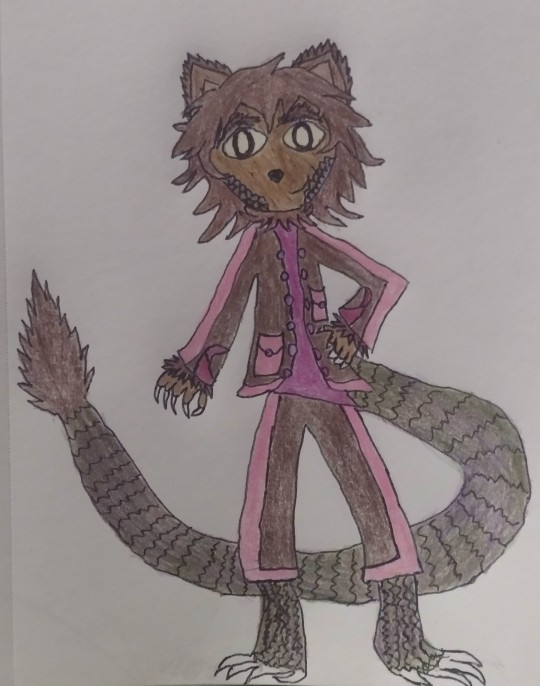
(family and friends now wish she would discover a hairbrush)
This is one of my OC’s from The SOS Chronicles, Silvie, the (feral) little Aguithan girl that Oliver and Silas befriend in book 2. When she’s not sneaking around on special missions and trying to help her friends save her planet from its evil overlord, she likes wearing bright colors since she never had the opportunity before. She especially likes pink because someone (probably Andy James, the only person with any fashion sense in this series on account of growing up with at least 4 sisters) told her it looked good on her. This pink and brown jacket is her favorite article of clothing and she wears it everywhere when she doesn’t need to be sneaky. The matching pants were just a bonus.
I’m also realizing that I think this is the first time I’ve drawn her in color??? So a little breakdown here: her fur is brown and it covers her face, arms and torso in varying lengths as you can see. Her legs and tail are scaled and iridescent, which is unfortunately very hard to show with colored pencils but I did my best by blending olive green and a few shades of purple together. I don’t know if you can tell, but her eyes are yellow.
#the sos chronicles#silvie the aguithan#silvie starfell#aguithans#not all aguithans look like this their fur colors vary just like cats!#their tail colors also vary#face scales slowly develop as an aguithan kitten matures#in the series silvie is about 10-12#I can't believe the first time I've ever drawn a color-coordinated outfit I did it for my feral kitten OC#the jacket is probably new here but it gets mended a lot#silvie would wear it until it turns to rags that's the autism for you#can't get over how stinkin cute she turned out look at this lil baby#when she has to sneak around she wears greens and browns and grays#she likes green a lot too it's probably her second favorite color#drawings#art#my art#sci fi#science fiction
8 notes
·
View notes
Text
tbh i don't think it is realistically a good idea but it's interesting to wonder if cats could evolve the vast differences of physical traits that dogs have if they were selectively bred that way
#cat breeding is extremely new#in the past rhe differences in cats mainly just existed in their fur colors#brown tabby is the default but black cats are created by a cat having the nontabby gene#orange cats from a form of erythrism (which can be seen in other mammals as well) that replaces black coloring with only red#colorpoints from a specific form of albinism that is also seen in some other animals such as mice and rabbits and while thought to not exis#t in dogs before has recently started appearing in a few dachshunds#etc etc you get the point#recently in the past 100 years as cat breeding became more popular different physical traits such as face shape tail type fur type body type#has started to diverge#so i imagine in a few hundred years maybe cats actually will be as varied as dogs are who knows#meowing
2 notes
·
View notes
Note
You mentioned dog beauty standards - what would they be? What would the ideal dog look like in their time and place?
I think a few common human beauty standards can be applied to dog people as well. Symmetrical features, balanced proportions, cleanliness, good health, good teeth, good posture, pleasant voice and confident gait.
In Vasco's and Machete's setting, men are expected to be athletic but youthful, have enough muscle definition to appear virile and sculptural but also retain some natural curves. An ideal woman is delicate and feminine but also full-figured, soft bodied and robust enough to bear children. Failing to appear vital and lively is a huge minus.
Fur is immensely important in dog world. Length and color doesn't matter but it should be dense, lush and shiny and obviously be free from dirt, odors and parasites. Beauty-conscious dogs with dark fur try to avoid having their coats bleached by the sun. Mange is greatly feared as it almost always comes with public shunning and loss of social status.
Dogs don't have much exposed skin but it too should appear healthy and smooth. Softer paw pads and glossy, neatly trimmed nails signify high standard of living.
In this particular time and place, slightly rounder and softer facial features are favored. Big, dark and round puppy eyes are seen as particularly beautiful. Symmetrical face markings are desirable, but some dogs become known for their unique and visually striking patches and spots. Vibrant and warm colors are generally more praiseworthy than more muted shades and fur dyeing isn't unheard of, but it takes a lot of time and effort to maintain and is too costly for most dogs. Tail standards vary between different types but carrying it high is usually seen as an attractive trait. Thickly furred and well groomed tails are well liked. Ear cropping and tail docking is a tradition comparable to body modding in some communities, although at this time most people that practice it are peasants and commoners.
#answered#nurmilintunen#Vaschete lore#Vasco is generally seen as well-rounded conventionally attractive guy with strikingly golden fur charming smile and warm friendly eyes#the distinct beauty marks on his cheeks are a cherry on top#Machete on the other hand would fit right in in the consumptioncore Victorian England and it's glamorized suffering#but for Renaissance ideals he's just too waifish and pointy and unmanly
510 notes
·
View notes
Text
Sweet lolita through the years
Part 2
2005-2008 (ish) “midschool” sweet
Moving out of the oldschool era we start to see sweet Lolita becoming more like we know it today. While solid color mainpieces and simpler styling were still common, printed pieces and more accessories were becoming more popular.
This transitional period between oldschool and the iconic 2010s ott era is often left out in conversations about Lolita history despite it really having its own interesting trends.
In general this era was very glamorous in its trends- gyaru was a huge influence on the trends and you can absolutely see that influence.

This is the period where balancing colors and having elaborately themed coords started. Brands really started to have their own styles and identities.
As a sort of in between of heavy prints and solids appliqué prints and screen prints were very popular at the time. Brands put a lot out and the community caught onto this trend very quickly
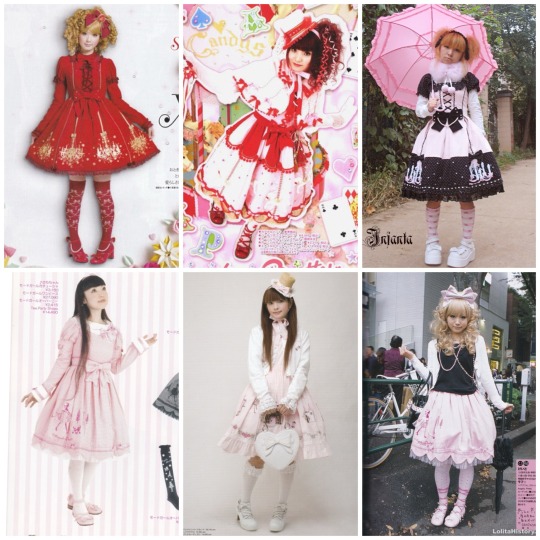
I also often see coords from the early part of this era mislabeled as oldschool despite them already being quite modern. I do think there’s overlap, especially around 2005-2006 but familiarizing yourself with the styling differences makes it pretty easy to see the differences. The “new” way of coording at the time was far more sweet, more elaborate, more detailed, and more accessorized. THIS is the period where tea parties, modern usakumya designs, baby’s heart bags, and many other iconic designs that are often labeled as oldschool were made. Mislabeling them as oldschool both harms the ability to properly emulate oldschool and erases the history of the transitional period between then and the ott era. Wrist cuffs were also becoming common place at this point.
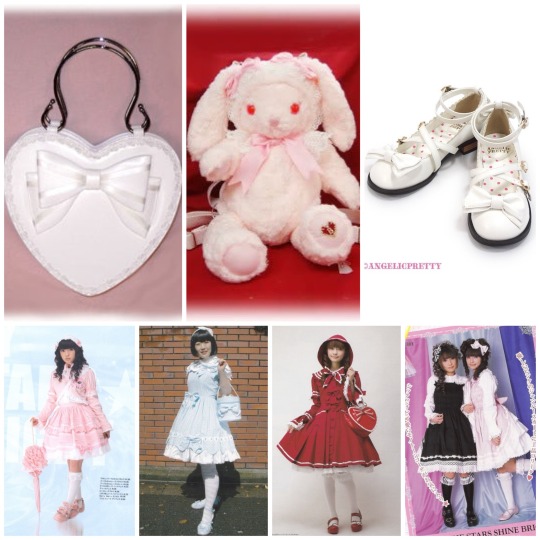
Printed socks started to become both more elaborate and more popular though lace topped otks stayed pretty common and popular in this period.
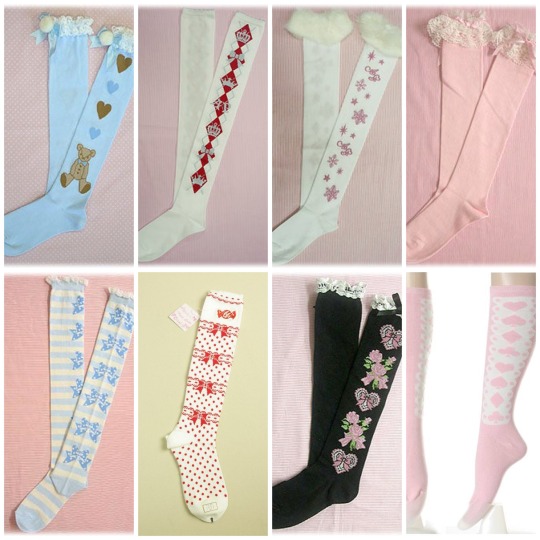
Jewelry got more detailed and cutesy. Plastic jewelry started to become more common, however more detailed metal jewelry was the majority of what you’ll see. Jewelry and socks that matched the motifs of dresses started to become the standard at this point.
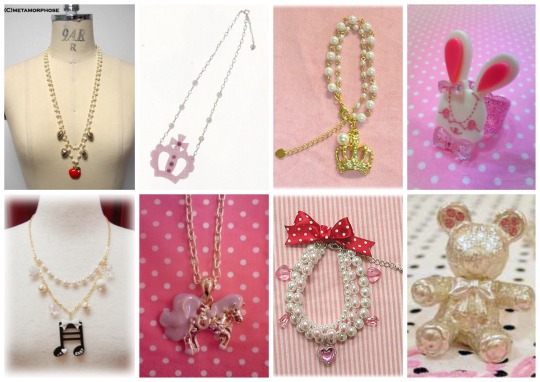
Other accessories were very varied though mini Alice bows were really the most popular and common. A lot of fun and experimental headpieces like plastic headbands, mini hats, and the always iconic napayoshi bunny bonnet were made in this time.
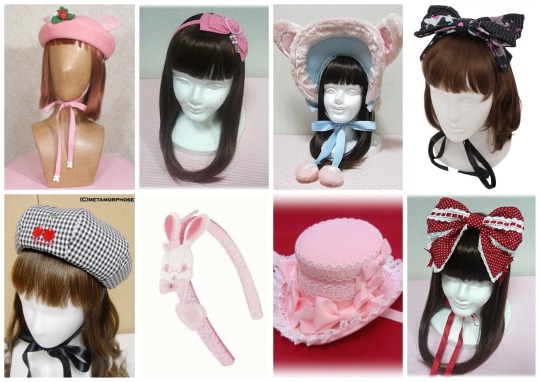
Novelty bags and heavily printed totes also started to become more common and popular. Strangely it seems that plush animal bags fell out of popularity until the tail end of this era moving into the ott craze. Printed hand bags were the most popular, but some shaped novelty bags were still made- especially towards the end of this period.
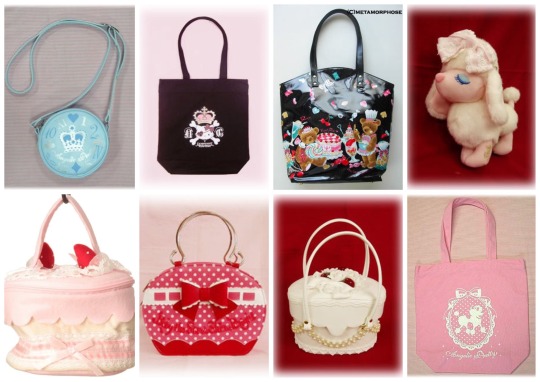
This is one of the first Lolita eras where hair and makeup became a big part of styling a coord. With the popularization of gyaru you could see many influences in how Lolita’s did their hair and makeup both in this period and in the 2010s. Though the makeup was simpler and typically didn’t veer into full gyaru territory until the later part into the 2010s
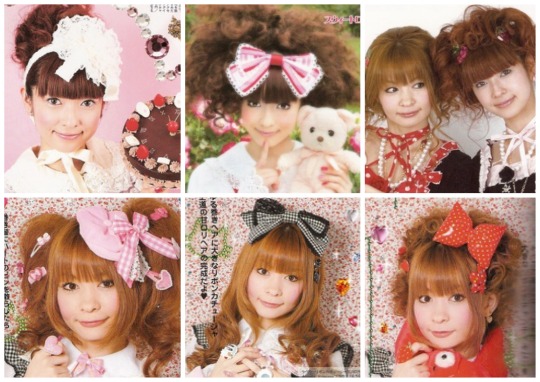
More accessories like wrist cuffs, faux collars, brooches, gloves and little chains that clipped from one jsk strap to the other were seen at this time too. Faux fur in details was extremely popular with some brands even including fur trims on their mainpieces. Pearls, polkadots, charms, and florals were all also rampant.
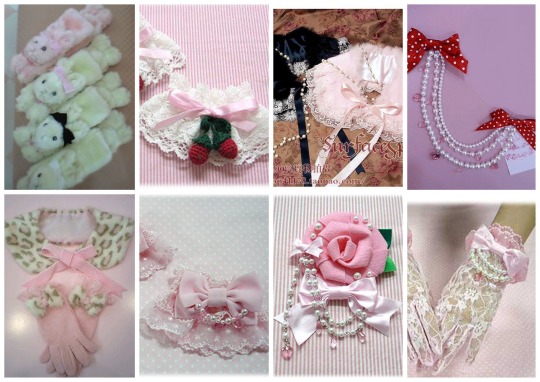
Motifs were all over the place at the time but some of the most popular / common were: poodles, cakes / sweets, polkadots, Alice / card / trumps, berries, crowns, cats, houndstooth, florals, and crowns!
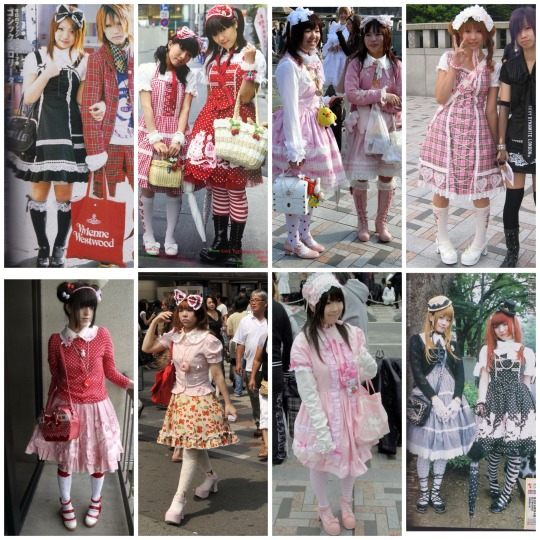
Thanks so much for reading, if you’re interested in reading more see: part 1 part 3
547 notes
·
View notes
Text
Tiefling Physiology Headcanons that nobody asked for!
I've been thinking a lot about tiefling Physiology and body language, but have found precision few resources on the subject. So I wrote my own! My fellow fanfic writers, please feel free to use this!
Includes physical traits of Tieflings and some body language (and by that I mean the tail)
Claws: Modified nails that are thicker, stronger, and sharper than human nails. They grow rapidly, typically ending in points.
Teeth: Rather than having four canines (two upper, two lower), Tieflings have 6 to 8 (double canines on the upper jaw and either single or double on the lower jaw). Canines are elongated and much sharper than those of most other races.
Horns: The horns of a Tiefling are made primarily of bone, with a protective keratin layer. Their inner structure is not solid, but resembles a honeycomb, with blood vessels and nerves (I based this off of a cow's horn structure). Breaking a horn is excruciating and results in significant bleeding. Eventually the broken horn will develop a boney callous or cap to protect the inner structure from damage or infection. Horns DO have sensation, similar to that of fingernails in humans. Their primary function is dissipating excessive heat from the body and maintaining body temperature.
Ridges: Each Tiefling's pattern of ridges is subtly unique, though most follow a similar pattern: cartilaginous and bony bumps and/or ridges adorn the body. Ridges are most common on the elbows, upper arms, shoulders, chest, shoulder blades, along the spine and into the tail, hips, and thighs. Some (typically males) also have facial ridges along the brow, cheekbones, and chin. On the shoulder blades the vestigial remnants of wings can be found, including a claw-like spur.
Body Temperature: Tiefling body temperature can range from 99°F to 102°F (37.2°C to 38.8°C), making them noticeably warmer than other humanoids.
Eyes: Tiefling eyes can have either black or white sclera (some say that this is connected to parentage, white being human parents and black being from tiefling parents, but these claims have not been substantiated) and irises of almost any color with glowing, dancing flames framing the pupil. Pupils can be rounded or vertical slits (cat-like).
Tongue: A tiefling can have either a single pointed tongue or a forked tongue. In either case, the tongue is usually slightly longer on average than a human's.
Ears: Tieflings, like elves, have pointed ears which can be highly sensitive to stimulation.
Vocalizations: Obviously, Tieflings can talk, but they also have a range of other vocalizations. Growling, snarling, and even purring have been observed.
Tail: The tail is prehensile, usable to pick up and grip objects, assist in balance, express emotion (usually unconsciously), and can be used as an improvised weapon (not for stabbing, but it makes an excellent whip.) Some tails have a barb or spade-like structure at the tip, which is made of flexible cartilage. Sensitivity varies for each individual, but commonly the tail is not overly sensitive at the tip, but the base and underside can be.
Tail posture and movement can be very informative on a tiefling's emotions:
Happy/Excited: Tail is upright with the tip flicking or waving forward and back.
Angry/Agitated: Tail is low and whipping from side to side.
Nervous/Anxious: Tail is either tucked or wrapped around the tiefling's own leg.
Affectionate: To express affection (typically romantic) a tiefling will wind their tail around another person's ankle or wrist. If the other person also has a tail, they may link or intertwine tails. This is usually done as a romantic (but polite) gesture but is also seen with parents and children. It's equivalent to holding hands.
Possessive/Protective: A tiefling may wrap their tail around their partners thigh or waist if they feel possessive or protective. This is typically frowned upon in public as it is fairly intimate.
Presenting: When a tiefling is interested in someone sexually, their tail will be held up in an "S" shape. This is done by both males and females, and usually subconscious...which can lead to some very awkward situations...
#bg3 rolan#baldur's gate 3#bg3 dammon#bg3 alfira#holy rolan empire#bg3 fanfic idea#bg3 fanfic prompt#tiefling#bg3 cal#bg3 lia#bg3 zevlor#zevlor#bg3 lakrissa#headcanon#bg3
501 notes
·
View notes
Note
Just started reading and I really love everyone so far 😍
I was curious though could we make our own funky little aliens at some point? They seem so cool!
Yeah sure why not. I don’t have energy to explain every nuance right now but if you want to just have fun and create your own alien I have a bunch of general rules and this shitty drawn note👍

Their hair is always pointing backwards. Although individual small strands may stick out in different directions.
Often there are antennae strands at the place of the nose or forehead, which are also almost always turned back.
Their head shape can vary as you wish. You can do the same things with their skull shape that you would do with a human character. The holes that replace their eyes can be of different shapes, but there are always four of them. The tail can end in any funny shape that can be made with fur, or it can be nothing at all.
No “woman's” boobs. These aliens don't feed their babies milk. So if you want your character to have nice boobs, you'll have to send them to the gym.
You can paint them literally any color you want. I'm not sure about the spots yet. Maybe they could have different color spots on their fur.....
As for their uniforms, I'm totally improvising at the moment and I think you'll have to as well :/ The only permanent detail is small spikes on their arms or legs, but they're optional
946 notes
·
View notes
Text
I see at least one cool bug a day, and usually many more, but it’s not because I live anywhere particularly rich in strange, wonderful creatures (I live in an unremarkable corner of Pennsylvania, USA) or spend all of my free time looking for bugs (well, just *most* of it). in my experience, finding interesting bugs is less about actually locating them and more about looking closely at tiny things you’d otherwise ignore!
this very long post was compiled over a couple days in late July, although I spent less than 10 minutes at a time searching. there’s a lot of fun creatures just out in the open.
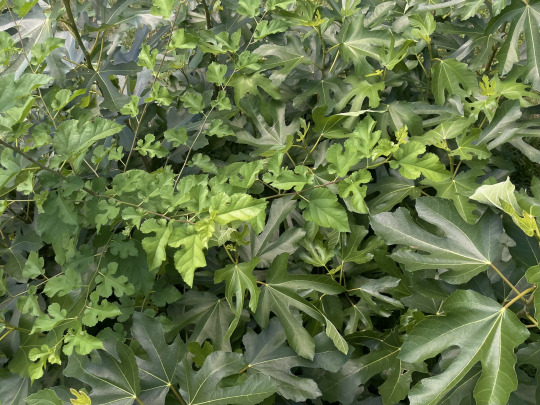
plants are always a good place to start when looking for bugs, and I chose this small fig tree (Ficus carica) with a mulberry sapling friend. feeding on the sap of the fig and mulberry is the first group I’ll take a look at, the planthoppers:

these two are flatid bugs, Metcalfa pruinosa and Flatormenis proxima. flatids are slow-moving bugs that can be approached closely, but once they get tired of circling around stems to avoid you they may launch themselves into a fluttering flight with spring-loaded rear legs.
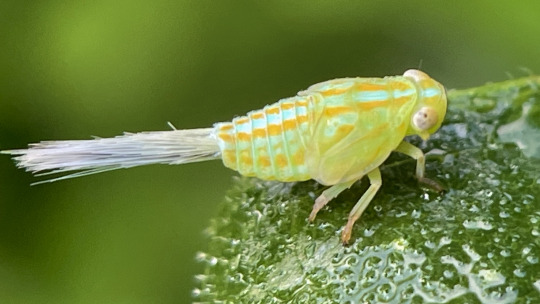
Aplos simplex, a member of the related family Issidae, also likes fig sap. its “tail” is actually a tuft of waxy secretions, which get shed along with the bright colors when it assumes a lumpy, bean-shaped adult form.
cicadellids, or leafhoppers, are just about everywhere on plants, but can be hard to approach without scaring them.
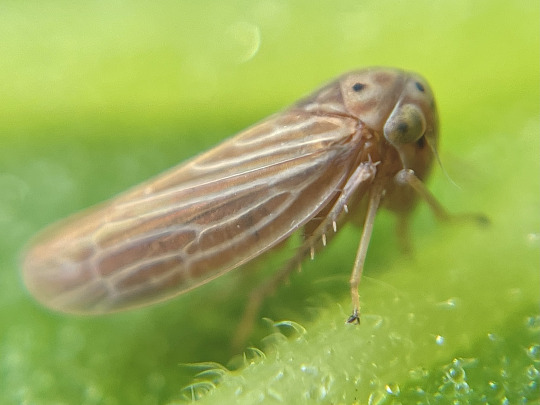
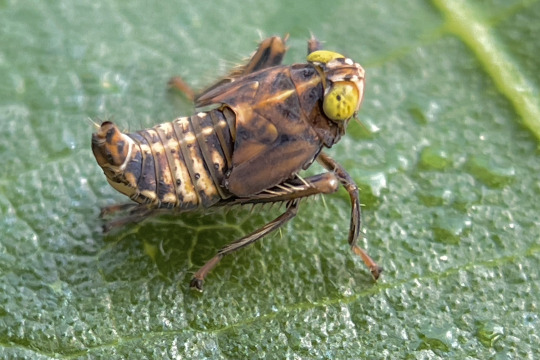
Agallia constricta on the left is a tiny species that feeds on grass, but many were scared up onto the fig by my footsteps. Jikradia olitoria is a much larger species that does feed on the fig; juveniles like this are curled, creeping goblins while adults’ rounded wings give them a pill-shaped appearance.

this big, pale leafhopper belongs to genus Gyponana. it’s tricky to get to species ID with these.
Graphocephala are striking little hoppers that eat a variety of native and nonnative plants. G. coccinea is the larger, more boldly colored one and G. versuta is smaller but more common locally. they’ll sit on the tops of leaves but take flight if you get too close quickly.

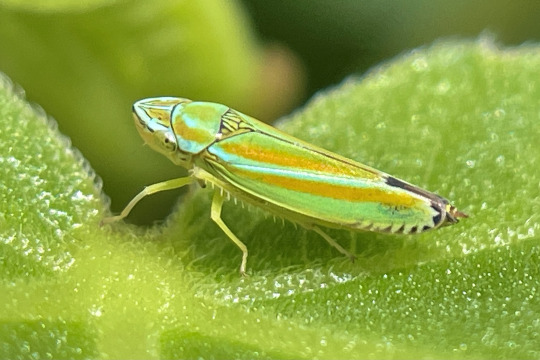
another group you’re almost guaranteed to encounter are flies (Diptera). these are a very diverse group, so much more than houseflies and mosquitoes (though I did run into both)
where I live, any plant with broad leaves is almost guaranteed to have a few Condylostylus, long-legged flies that come in shades of blue, green, and red. despite their dainty physique, they’re agile predators, typically feeding on other small flies.
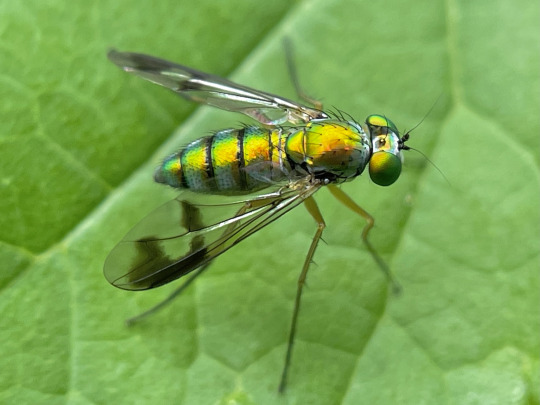
next, a few hoverflies: the ubiquitous Toxomerus geminatus and a Eumerus that I’ve been seeing a lot of this year (but maybe I’ve just noticed them for the first time). syrphids have varied life histories, but most adults drink nectar and many of the larvae are predaceous on aphids.
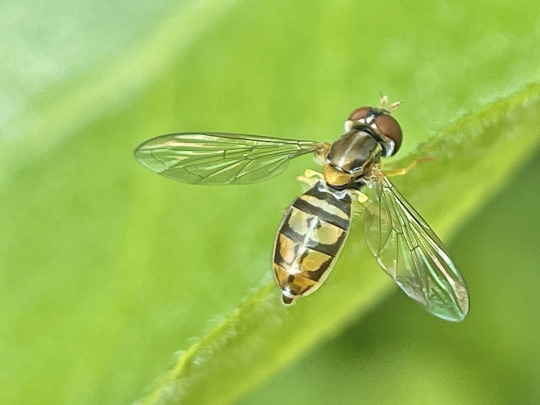
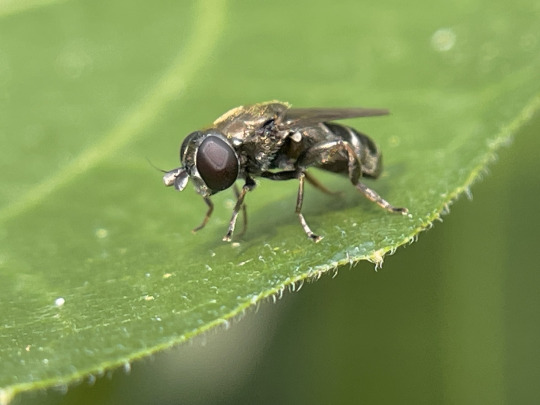
the metallic green soldier fly is Microchrysa flaviventris, nonnative here. Coenosia is a fun example of a “fly that looks like a fly,” with big red eyes and a gray body, and you might think they’re just another dung-sucking pest, but they’re actually aggressive predators! this one seemed to have nabbed itself some sort of nematoceran fly, maybe a fungus gnat.
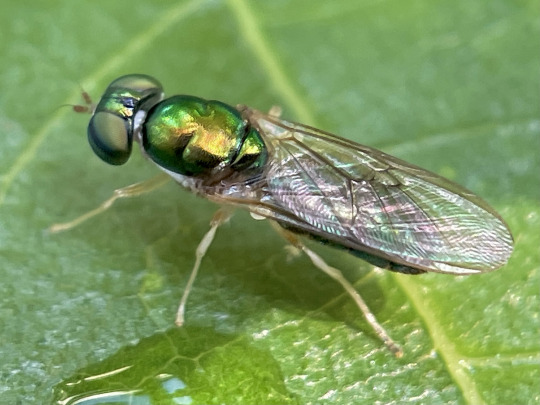
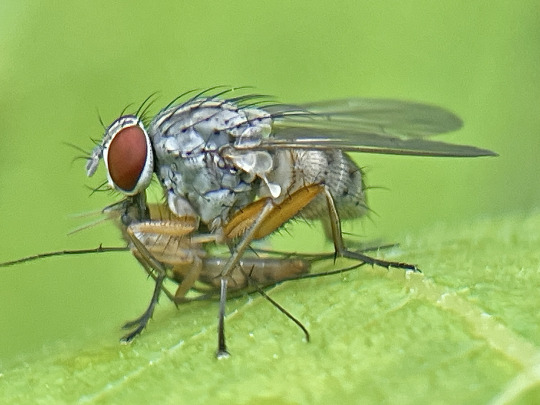
many flies are very tiny, just millimeters long. the first two little fellows are lauxaniids, while the last one, an agromyzid leafminer Cerodontha dorsalis, burrows through grass leaves as a larva.
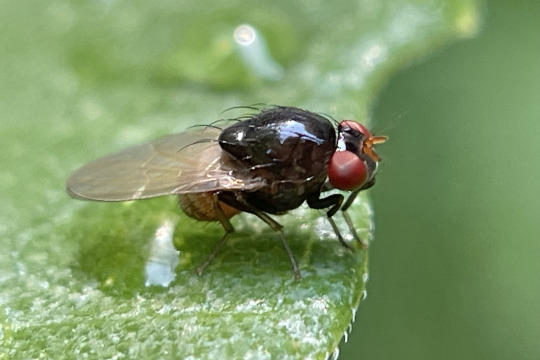
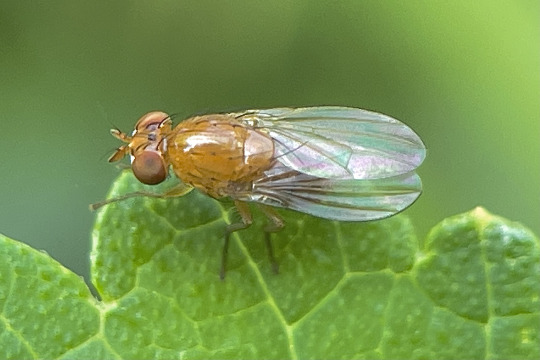
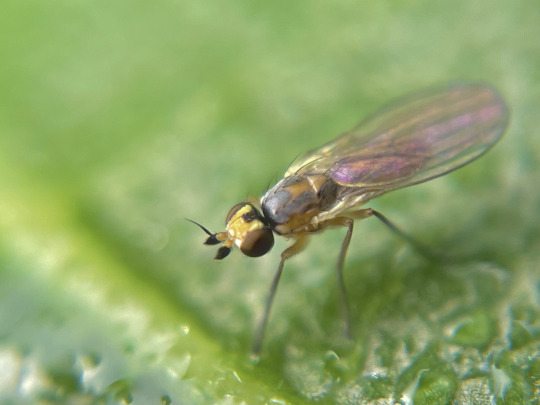
while moths and butterflies (Lepidoptera) are drawn to plants for their flowers or to lay eggs, many small moths can easily be found resting on or under leaves during the day.
these first two are tortricids, many of which are flat, rectangular moths resembling chips of bark or dead leaves. the apple bud moth, Platynota idaeusalis, feeds on a wide variety of hosts, while this beat-up old Argyrotaenia pinatubana would have developed in an edible tube nest of pine needles.

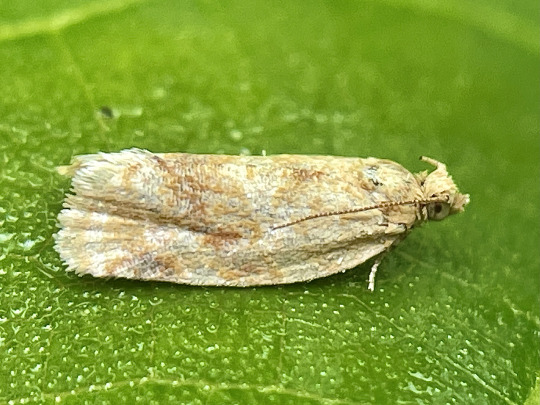
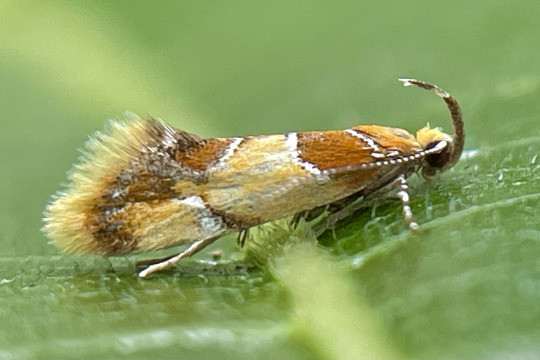

Callima argenticinctella feeds in bark and dead wood (a resource used by more caterpillars than you’d realize!) while the last moth, possibly an Aspilanta, is a leafminer.
although beetles (Coleoptera) are famous for their diversity, I didn’t find too many on the fig. the invasive Oriental beetle Exomala orientalis resting here can be found in a wide range of colors, from this common tan to to deep iridescent black. the other beetle is a Photinus pyralis firefly, sleeping under leaves as fireflies do.
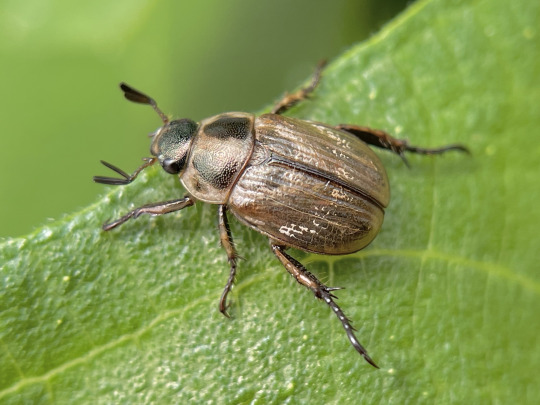
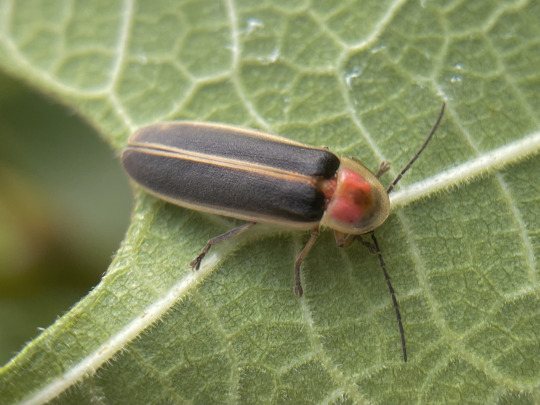
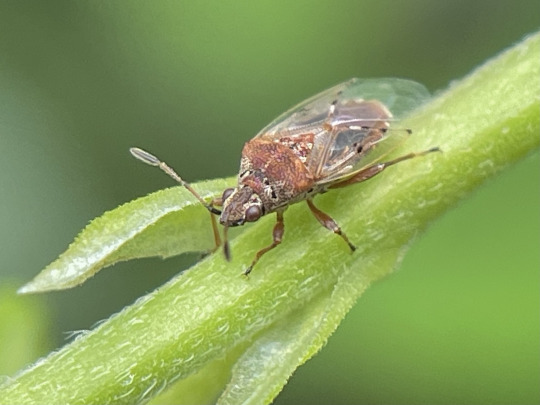
a few spare hemipterans: a Kleidocerys resedae that blew in on a wind, and below, the mulberry whitefly Tetraleurodes mori feeds on its namesake host. as for Hymenoptera, I saw manny tiny parasitic braconid wasps and various ants attracted to the planthoppers’ honeydew excretions—always worth checking underneath roosting hoppers for things having a drink.

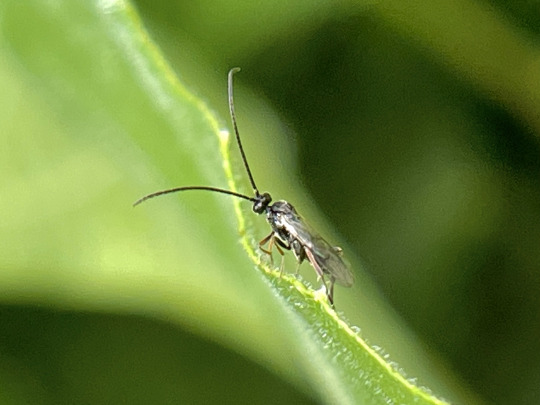
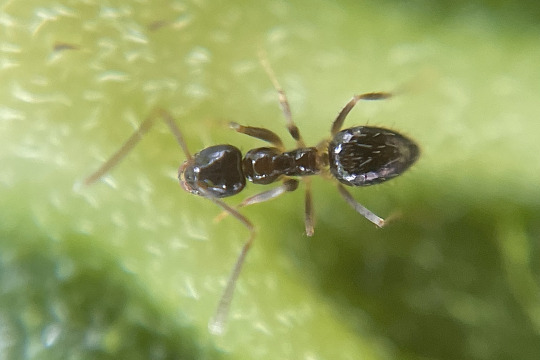
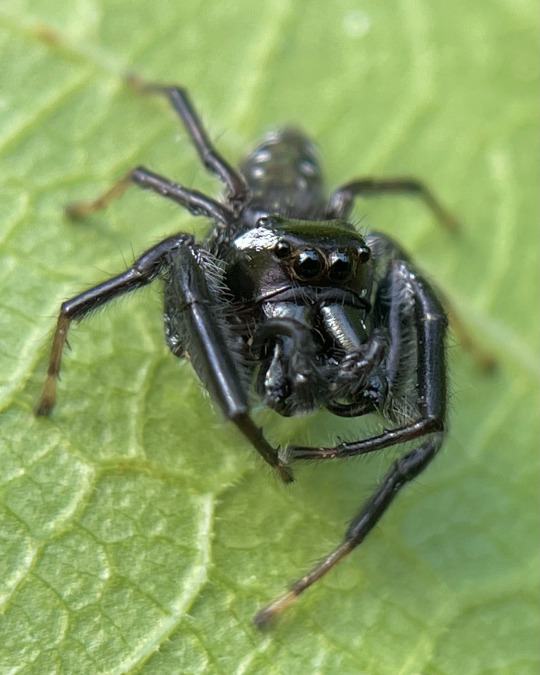
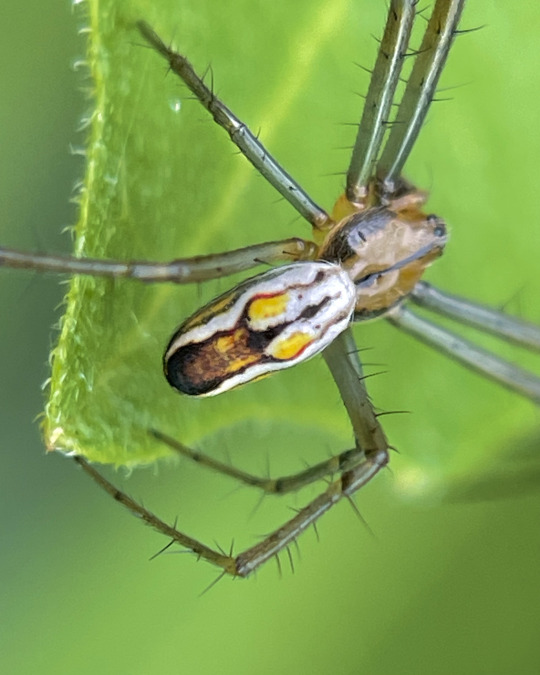
a couple handsome spider boys were scrambling through the fig seeking females, a jumping spider Paraphidippus aurantius and an orbweaver, Mecynogea lemniscata.
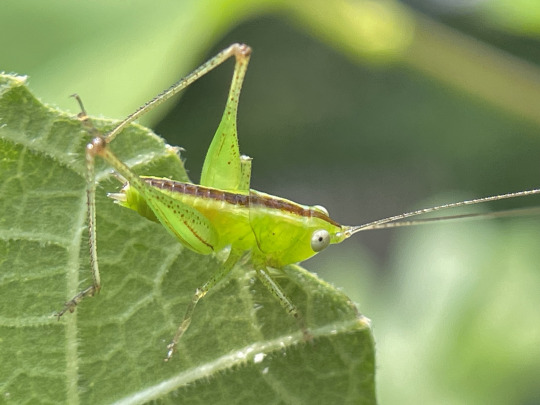
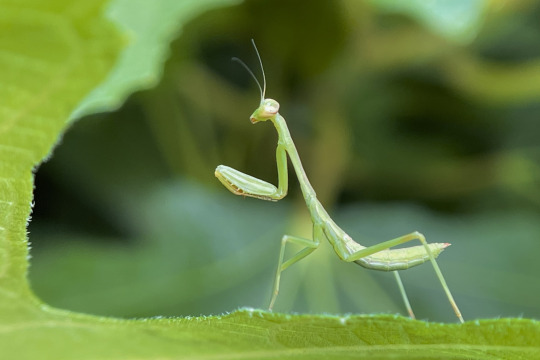
and to round it off, a young Conocephalus meadow katydid and a Carolina mantis, Stagmomantis carolina.
there’s 31 species of arthropod in this post, and I probably saw some 45, not all of which stayed for photos. if you walk slowly and look closely, you can see a sizeable chunk of your local biodiversity in under fifteen minutes! of course this will depend on where you live and what time of year it is, but there’s almost always more cool bugs out there than you’d expect, even on just a single plant.
1K notes
·
View notes
Text

A braithuvi horse at rest under the close protection and watchful, scary, pale-eyed gaze of her herd's guardian, a dírgrahdain. Both are landraces developed within the Highlands. The ancestors of braithuvi (and other Highlands native horses) were brought overseas by the ancestors of the Hill Tribes, while the dogs were obtained from native livestock guardian landraces used by proto-Wardi tribes. Each have become distinct over their centuries of living in the Highlands, and dírgrahdain are have a particularly unique place in the cultural schema.
Braithuvi are a woolly horse breed (and one of many, wool horses are widespread, second only to camala in value for textiles) that are also somewhat specialized for milk production. Their meat is relatively poor (other horses are preferred), but they produce high yields of milk and thick, continuous growths of wool.
Horses are not as culturally significant as cattle to most in the Highlands, but are still highly valued animals that are critical to subsistence. Few plant-based textiles can be produced in the Highlands, and almost all in the region are made with braithuvi wool. They can eat a greater variety of forage than cattle, more efficiently converting energy intake from pastures into milk and wool. Their milk is considered to be the very best of all livestock, and is usually what is used to make the prized murre beverage.
Dogs have a very small specific place in the cultures of the Hill Tribes as utilitarian working animals (specifically for livestock and occasionally as home/village guardians), and rarely ever fill other functions. The practice of keeping dogs purely for companionship is virtually nonexistent (though affectionate bonds between people and their herding or household guard dogs will be fairly common), and their meat is considered worthless. Most dogs are not elevated within the cultural schema, and tend to be merely appreciated as useful, loyal animals. Livestock guardian dogs are an exception to this, and tend to be of more significant cultural import. They are animals that exist to protect the herds on which all subsistence depends, and thus have an elevated cultural status and roles in religion and folklore as uniquely protective entities.
Dírgrahdain are the key livestock guardian dogs in the region, and the only natively developed LGD. Their name means 'lion dog', both in reference to their maned appearance and their ability to fend off and even kill the largest of predators. The dogs are characterized by tall, long-legged builds, deep chests, a curly tail, thick hair (and a thicker winter coat), and a shaggy mane. Their bodies tend to be thinner and lankier than their fur coat suggests, but still well-muscled and powerful. Their coloration can vary wildly, but a black mask with a brown or reddish body like this is most typical. Unnerving, pale eyes are prized in these dogs, with the belief that they not only intimidate predators but are uniquely potent at fending off malicious spirits.
The dog's exclusive function is to protect livestock. They are used primarily for the defense of horses, which are small and very vulnerable to predators (lions, hyenas, king hyena, wild dogs, jackals, nechoi, and even eagles can be threats), though some dogs will usually be posted up with cattle herds to deter raiders.
Pups are most commonly born in the field among their herds. They will be carried in their master's coat while still nursing, but will be allowed to join their mother in her duties from the moment they are strong enough to follow. Dírgrahdain live with their herds day and night. Most will never see the inside of a home, and most seem to prefer it that way. They form close and protective bonds with their charges, and will thoroughly integrate themselves into the social fabric of the herd.
These dogs are not human-oriented, and will usually only form bonds with people that they have imprinted on as puppies (and will merely be cool and polite to those met later in life). They are highly aggressive towards strangers, and introductions must be done incrementally and with great care. This is desirable, as this trait makes them an excellent line of defense against livestock raids. Their loud, booming barks can alert of intruders from a great distance, and they can often successfully intimidate khait, causing some mounted raids to end in humiliating failure. Dírgrahdain are often killed in raids, either to fend off the attacking dog or to silence it before its master can be alerted. This is not outright dishonorable, but not something one will be commended for. Cattle raiding culture here values swiftness, stealth, and strategy- such smash and grab tactics are seen as brutish (and will often result in harsher retribution).
Like most LGDs, they primarily defend their herds by displays of aggression and power, using their loud bark, fearsome growl, and powerful bodies to chase and intimidate predators away without physical contact. Even so, it is necessary for all working dírgrahdain to be willing and able to physically confront predators when necessary. A well-trained, well-bonded dog will defend their herds with their very life, and is often effective in combat against even very large wild predators. Their dense ‘manes’ offer a degree of protection from wounds to the throat, and may be supplemented with spiked collars.
If a mother dog kills a predator, it is often customary to open the carcass and lead her puppies to feed on it. This is thought to teach the pups to be fearless against their enemies, and that they will grow up to be uniquely powerful and brave adults. Pups are given names upon reaching adult size, and ones who have consumed the flesh of predators will get unique names related to their mother's kill, or epithets as supplements to a given name (the exact details of this practice culturally varies). One might encounter dogs in the Highlands named things like Lionsbane, Hyena-killer, She Who Bites Jackals, Lion-Fed Shaggy (Lion-Fed being the honorable epithet, Shaggy being the dog's name, possibly given by a very small child)
The mere gaze of a dírgrahdain is said to fend off malicious spirits, and their thundering bark can scare away even the most dangerous of mountain devils. Their shed hair is needle felted into little dolls (usually into the form of dogs themselves) and placed into the cradles of infants and worn as charms by children to protect them from harm (both mundane and supernatural). Manes taken from dead dírgrahdain have uses among some of the Hill Tribes, and are typically only allowed to be used by their masters (unless recieved as a gift). The most prominent usages are being worn to fend off evil spirits and predators while traveling alone, and some traditions involve placing the manes around the necks or across the bellies of women in labor as a means of spiritual protection for mother and child during birth.
The Hill Tribes and Wardi both identify the same constellation along the ecliptic as a dog. In the case of the former, this stellar dog is identified as Mak-Urudain, a gigantic dírgrahdain with fur the color of flame and eyes as bright as stars, who is the eternal guardian of the Celestial Fields. He allows the souls of the worthy dead to pass into the afterlife and for esteemed ancestors to descend back to the land to guide the living, while preventing malicious spirits, devils, and the dishonored dead from entry.
One Bernike tale describes her attempting to fly into the Celestial Fields to steal the heavenly cattle who graze there. She took the form of a golden eagle, pretending to be an ancestor returning from a sojourn to the world of the living in order to get past the guardian hound. Mak-Urudain was not fooled for long, and led her on a long chase through the night sky before capturing her and hurling her out of the Celestial Fields.
She was never able to even touch the ground of the Fields (much less take any cattle), but had just enough time to take a single seed of heavenly grass in her beak. She returned to her mountain (missing most of her tail feathers and much of her pride) and planted the grass in her then-barren slopes. This is why the grass on Bernike's mountain is so tall and abundant and why cattle there grow so fat and healthy, like all cattle will in the afterlife. The howling winds heard from the mountaintops are playfully suggested to be the barks and howls of Mak-Urudain, calling down from the heavens to keep the witch grounded in the world of the living.
#DOG PARAGRAPHS: 2 (and lite horse material)#hill tribes#creatures#Brakul's chest tattoo is supposed to be a dírgrahdain but the only thing the guy who did it got right was the curly tail.#Everyone around him who gets past the 'ew whats with the tattoos' thing enough to make any non-disparaging comments#tends to assume that it's a kulimane and it pisses him off so fucking bad#And the worst part is that it really does look more like a kulimane than anything else#(Scenario was Brakul- barely able to speak Wardi- attempting to communicate a nuanced description of a dog breed to a guy who#absolutely could not be trusted to draw a recognizable dog to begin with and was tattooing him with a cactus spine)#(Janeys kind of looming nearby and using all 5.25 words of Urbinnas dialect he knows to confidently and incorrectly assist#in translation. Fully making it worse by intervening like 'he's saying he wants the ears bigger you fucking moron')#(at one point the dude gets to the tail and Brakul is just frantically gesturing a spiral shape into the air and that ends up being#only part executed more or less correctly)
396 notes
·
View notes
Note
What colors are the selkies on siren? Are they similar to the phlochids or do they have more unnatural varied colors like zetas?
this one made me realise i'd never coloured a selkie in properly before and was kind of just imagining them all like river otter coloured
but no we can have fun with it. their coats can come in any shade of 'natural' human hair colour (often many at once) and their skin does not necessarily have to match. the coat itself is incredibly thick and dense and also quite loose (they seem to have a lot of excess skin). their bare skin, found on their paddle tails, palms, and feet, has a very tough texture reminiscent of a beaver's tail

the vast majority of them are striped in some way and even the ones with spots are actually just striped as well (the spots are broken-up stripes). very dramatic high-contrast patterns are more common among pelagic people. some coastal areas have piebald populations too.
their eyes are always brown
122 notes
·
View notes
Text
Prompt 348
(Been a bit since I did an Ennead AU or Prompt, huh)
They had been… Shattered, torn apart, barely developed cores ripped from still living bodies left spasming and rotting, consciousness frayed and trapped in the shards. Had been pulled apart further, warped until they could barely remember what they were before, flashes of separate memories coming together to form knowledge they did not like.
They had… found each other, less alive and dead than before, only continuing to exist from the saturation of the surrounding ecto. Had cobbled themselves together, nine becoming four then two, then one singular core.
One being of Nine, dripping blood, dripping gore and viscera of the living, hair still grasped in their claws as they dropped a head. They were many, yet one, all of them buzzing around each other like the circling of planets.
Hands flex, the movement, feeling of living flesh novel to their senses. Senses that confirmed what they had long dreaded. They were the last- the others gone, dead, shattered beyond hope. They hope it was painless, even as they knew it was not. The scientists never cared about how much pain they caused, only that they got results.
Where were their results now? Where were their weapons and torture that they were so proud of? It didn’t protect them, and the Nine that were One couldn’t help the laugh. What use was freedom when everyone was gone? When they could feel reality breaking apart from the unbalance that even their power was useless in correcting?
The dead and the living, the living and the dead, always chasing after the other in an endless cycle. Now broken, shattered like them, yet unable to be put back together.
They laughed, a broken, croaking, sobbing sound as they grieved for those whose names they could no longer remember. Who were now Nothing, no name to be whispered to the stars, no grave for a mutilated corpse to be lowered. Only chunks of gore tossed aside when their torturers were done, discarded like waste.
What else is there to do, but Wail, to let out their fury and grief and anguish into the void even as the world crumbles around them? What else is left but to drift as the abyss trails ever-hungry. There’s no more Ancients, no more Humans, nor more Life, and no Death to claim them.
So they are left adrift, tails lifeless, form shifting between Beast and Other as time escapes them. For there is no Time, no Space, not here, not in this emptiness where even the Infinite would not dare touch. How long they drifted, wandered, they did not, do not, know.
Yet they know the moment something disturbs their aimless wandering, the fuzzy, sputtering feeling trying to wrap around a wrist. They stare, even if they see nothing, heads tilting and twisting as they whisper amongst themselves. What is it, they wonder, the sensation something strange and unfamiliar compared to the ever-starving feeling that had long since become normal.
So they let it take hold, it would never have succeeded otherwise, and they open their eyes not in the Nothing, but to the Sun.
(Been a while so have some of the art I did of the Ennead lol)



(In dragon form the main body goes from the head/neck colors to a black while the underbelly is iridescent- Also yes there's a torn opening on their chest like a wound or maw) (Humanoid form is about 15' and dragon form varies around 200' or larger)
#My art#The Class Pulls a Tiamat AU#Prompts#Danny Phantom Crossover#Reminder for who is part of the Ennead: Danny/Dash/Sam/Tucker/Val/Paulina/Kwan/Star/Wes#Morally gray Ennead#What crossover is this? Idk go wild could do multiple#DCxDP#DPxDC#DPxNaruto#DPxBNHA#DPxMarvel#DPxPokemon#DPxDCxPokemon#DPxLOZ#DPxHTTYD#Any magic or soul-seeing person is going to have a seizure looking at this thing#Could just have them yoinked to another DP AU too if you want#Danny Phantom#Ghosts are Dragons#Or at least it can be if you want#Go wild
189 notes
·
View notes
Text
April 20, Beijing, China, National Museum of China/中国国家博物馆 (Part 3 – Chinese Historical Fashion Exhibition):
Another cool exhibition that I visited while at the museum, showcasing popular fashion from different dynasties, historical artifacts, and some other relevant artifacts that gave a glimpse into the fashion of different dynasties. What's even cooler is that you can visit this exhibition virtually! (the site is in Chinese but I highly recommend it to everyone, there's so much more to the exhibition than the pictures I post here) Note that this exhibition does not only include historical hanfu, but also historical fashion of the 少数民族 that ruled some of the dynasties. This post will be pre-Ming fashion, and next post will be Ming and Qing era fashion. The reason is because Ming and Qing dynasties are the two most recent dynasties, so there are a lot of surviving artifacts from these two dynasties, which means there are 30+ pictures total and I couldn't fit them all into a single post.
First is a recreation of Han-era (202 BC - 220 AD) hanfu. The woman on the left is wearing a one-piece robe called a qujushenyi/曲裾深衣. The man on the right is wearing the outfit characteristic of Eastern Han dynasty (25 - 220 AD) civil officials, a combo of jinxianguan/进贤冠 hat and zaochaofu/皂朝服 clothing (皂 here means the color black, as in the word "青红皂白", or "blue and red, black and white"):
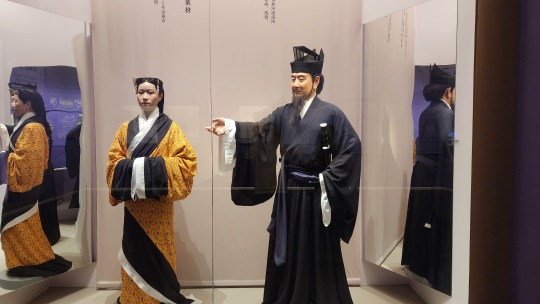
Left: model of a Han-era magpie tail cap/queweiguan/鹊尾冠 (you can see the influence of these Han-era men’s hats on the outfits of male characters in modern xianxia art). Right: recreation of a Han-era bian/弁 hat (the headscarf-like piece tied beneath the chin):
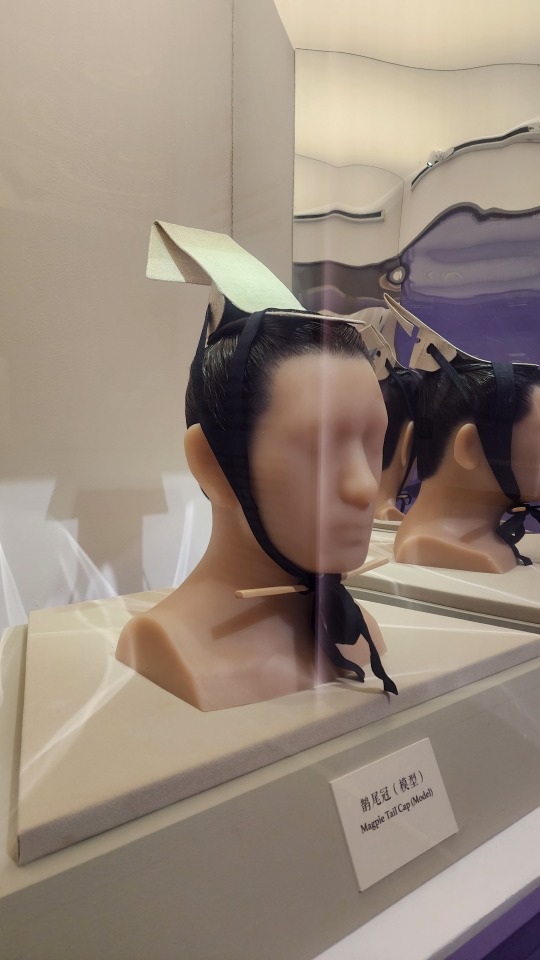
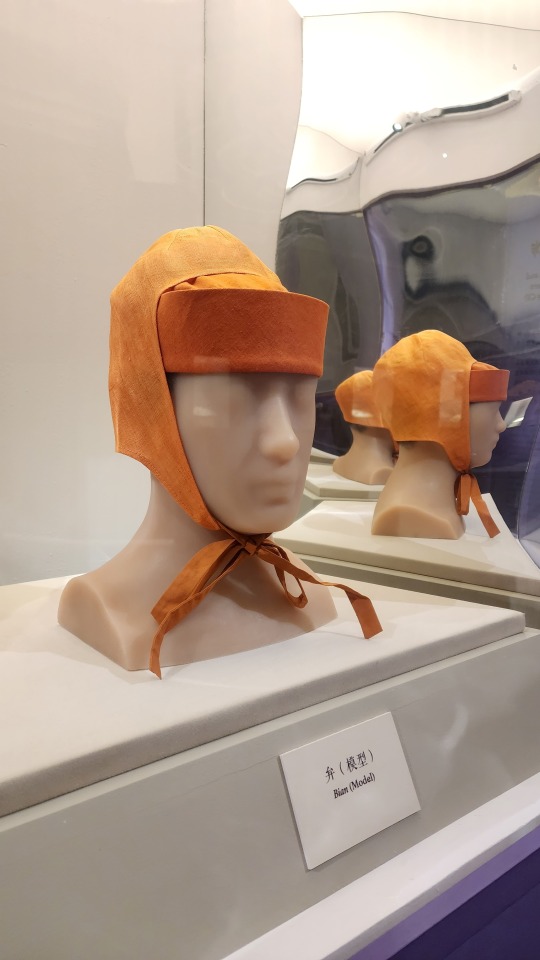
Line drawings of different hats worn by different types of officials based on artifacts and murals. The center and left sections are different hats of military officials (wuguan/武官 in Chinese), and the right section is different hat styles of civil officials (wenguan/文官 in Chinese).
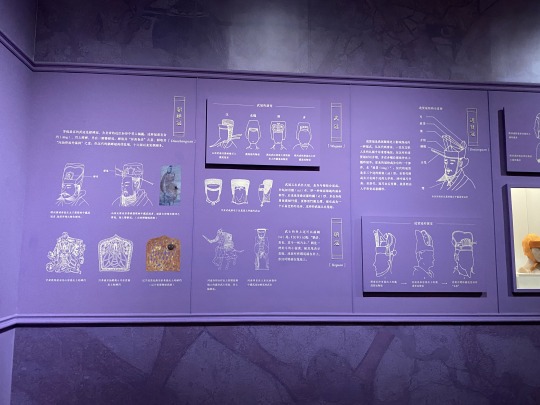
Jumping back, this is a Warring States period (476 - 221 BC) iron daigou/带钩 inlaid with gold and jade and decorated with dragons. Daigou are basically belt buckles where the flat end is attached to one end of the belt, and the hook will hook into slits in the other end of the belt, so this is an extra fancy belt buckle:
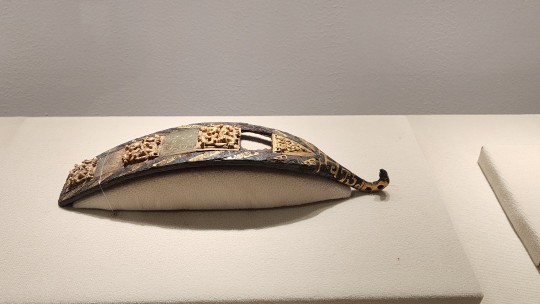
On to Tang-era (618 - 907 AD) hanfu. From the left to right these are: the regular outfit of early Tang dynasty officials (color varies by rank, red is worn by fourth and fifth rank officials), the outfit of a female servant in early to mid Tang era, the ceremonial outfit of a Tang dynasty emperor, and the outfit of noblewomen in late Tang to Five Dynasties era (907 - 960 AD):
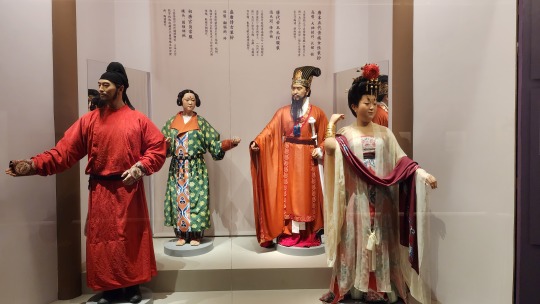
Song-era hanfu (front two) and Yuan-era Mongolian fashion (back two). Front left is the formal attire of Southern Song dynasty (1127 - 1279) civil officials (color varies by rank, red is worn by fourth and fifth rank officials), and front right is the regular outfit of women in Southern Song dynasty. Back left is the formal attire of Mongolian noblewomen in Yuan dynasty (1271 - 1368), and back right is the regular outfit of Mongolian men in Yuan dynasty.
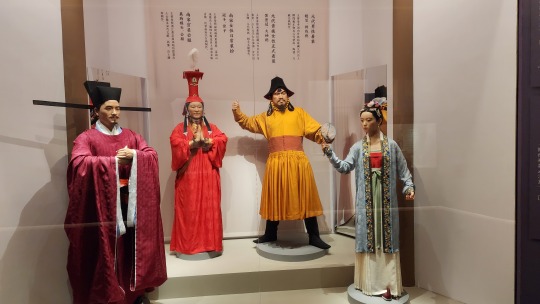
Replicas of painted clay sculptures of women from Northern Song dynasty (960 - 1127), the original sculptures are in Hall of the Holy Mother/圣母殿 of Jinci Temple/晋祠 in Shanxi province:
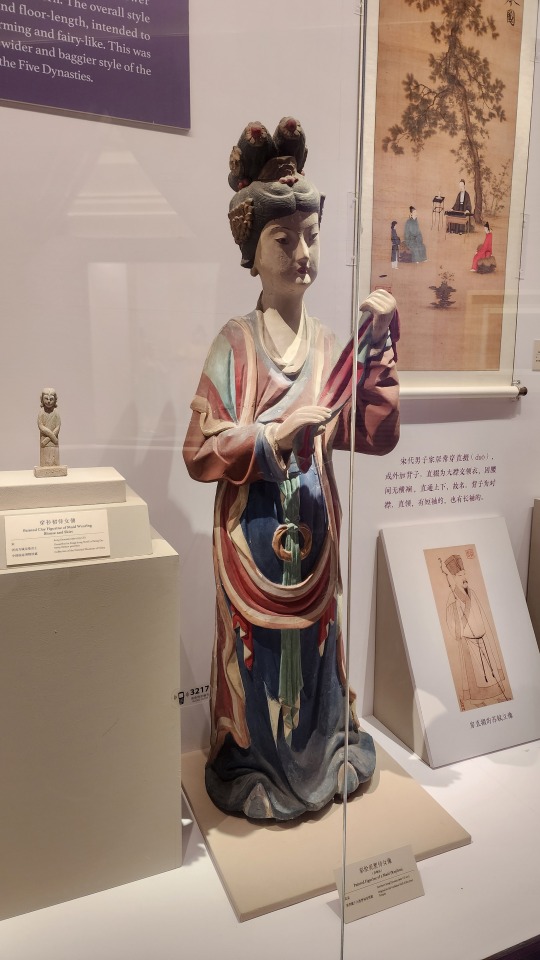
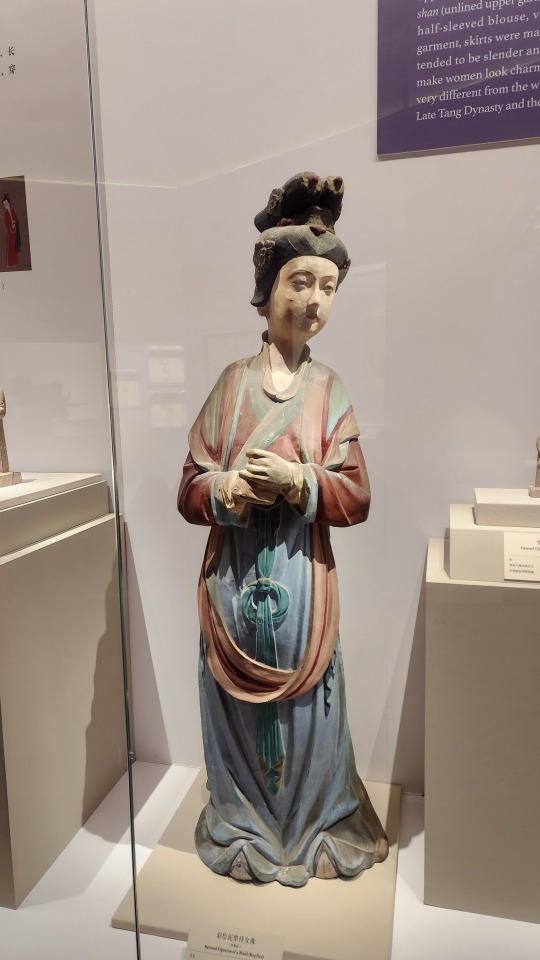
By the way, in the case of Song dynasty, the descriptor "northern" and "southern" basically indicate time periods within Song dynasty (you can refer to the beginning of this post where I explain this in more detail).
And line drawing diagrams of different styles of futou/幞头 hats in Song dynasty based on paintings, murals, and other artifacts:
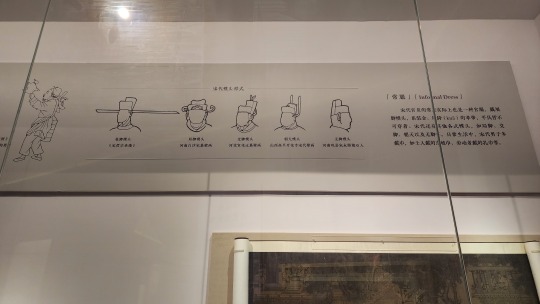
#2024 china#beijing#china#national museum of china#historical fashion#historical clothing#chinese historical fashion#hanfu#mongolian historical fashion#fashion history#chinese history#chinese culture#history#culture
140 notes
·
View notes
Text
LeafWing tribe sheet!
its over, i finally did them all. sorry this one took a while, ive been losing motivation, but at least its done!! honestly i love leafwings, so im glad i could get them out.

Physical Appearence + Traits:
-LeafWings are arboreal dragons, living in and relying on trees to hunt, shelter and sleep. Their talons are perfectly shaped to comfortably climb and hold onto branches, and their narrow wings allow them to swoop and weave through the trees without crashing.
-LeafWings’ colors, physical traits, and even demeanor shift and change with the seasons. During the summer, their frills and wings are rich green, and scales bright and glossy. They have higher energy and sleep less. During the fall, their colors shift to a warmer spectrum, their leafy frills start to flake off, and they start to prepare for winter. Once winter arrives, they lose their frills, tail-leaf and wing membranes, as well as turning duller and darker. They spend the majority of winter asleep, relying on the trees’ bare branches for camouflage, now rendered flightless. Finally, during spring, they wake up, their colors brighten, and their wing membranes return. The buds that grow along their backs open up and form their spine frills before summer begins.
-LeafWings are lithe and agile, and are very quiet fliers, especially when compared to HiveWings and SilkWings.
-During the summer, with their wings at their fullest, they can actually photosynthesize. They still need to eat food, but anytime they sleep during the day with their wings open to the sun, they wake up energized and not needing to eat for a while after.
-The coloration and shape of LeafWings’ wings varies both by region and individual. Some LeafWings mimic specific types of trees.
-Some LeafWings also have Leafspeak, an ability which allows them to communicate with plants and even control them if powerful enough.
Life Cycle:
-LeafWings hatch in clutches of one or two. They take around 5 months to hatch, and they are deeply reliant on their parents and their wider community. LeafWings are strongly protective of their dragonets. They also grow up somewhat quickly, reaching physical maturity quickly, but they continue to grow in size their entire lives.
-They partner for life, but often only raise one clutch of eggs (sometimes only a single egg) in their lifetime. The tribe is somewhat small as a result.
-LeafWings don’t have an official education system, instead relying on parents, peers and older, more experienced dragons to teach them what they need to know. LeafWings can then go on to pursue whatever tribe role stands out to them, using a sort of mentoring system.
Society and Culture:
-Before LeafWings were split into two groups, the tribe was quite peaceful and unified. The queen, by tradition, always had a council, and they lived nearby and alongside SilkWings. The tribe was known for being friendly and knowledgeable, and deeply dedicated to caring for the forest.
-LeafWings are also very resourceful. From various leaves, grasses, bits of wood, flowers, and insects, they could create baskets and rugs, thin slats of wood to write on, dyes, storage objects, and various weapons and food preparing tools. Learning to make and control fire meant they could progress faster. They were also talented woodcarvers, weavers and artists, sometimes trading not only supplies, but also various art pieces to and from the SilkWings.
-They were expert foragers, and had records of every type of tree, plant and animal in their forest. Many had small gardens of their own - medicinal herbs, spices, and plants they simply found pretty.
-Those with leafspeak were beloved and respected in the tribe, not dissimilar to animus dragons. Sometimes they would mould the shape of trees’ growth to create proper homes and nests for dragons to spend the nights, especially in winter.
-They have tribe-wide celebrations to mark spring, when they all wake from torpor, and the summer solstice, when they are at their highest energy and fullest lives.
-The SapWings, after the tribe was forcibly split, remained very similar culturally, though they lost their ability to trade and had to concentrate on survival in the poison jungle. The PoisonWings, meanwhile, changed dramatically. They became distinctly aggressive and warlike, taking their understanding of plants and animals and weaponizing them. They used the many venoms, poisons and sharp, dangerous objects throughout the jungle to their full advantage. A number of dragons died in the process, but those who survived became stronger.
-LeafWings believe that plants hold some level of consciousness, and some believe that they are animated by fully conscious spirits, each with its own unique consciousness and opinions. Trees are unanimously believed to be extremely wise and benevolent, and as deserving utmost care and respect. They are treated as if they were tribe elders themselves. It was once agreed upon by all leafspeakers that if a tree resisted a request, they were not allowed to make any attempt to force it to do what they wanted. Leafspeakers would also be used to make requests before cutting off any part of the tree to use - if it refused, it would be left alone. (It isn’t hard to imagine the way they felt when the entire forest was cut and burned down by the HiveWings.)
Diet: Omnivorous. LeafWings eat meat (birds, rodents, sometimes large mammals and reptiles), sometimes raw, sometimes cooked, and also a wide variety of plants, fruits and nuts. Because of the versatility of their diet, they have a great number of meals they like to prepare, usually garnished with herbs, spices and sweeteners like honey and certain types of tree sap.
225 notes
·
View notes
Note
Maybe a drabble in which our Lamb meets Chimaera Reader, the maker of all crowns? Like, he stumbles upon their lair, and sees all types of the crowns, big and small, black and white, one-eyed and two-eyed, etc.? Maybe even a little inter actions between the Reader and the Red Crown in which it recognises them as their maker?
Sorry for my English, it is not my native language-
Also sorry if this request repeats, tumblr May have doubled it-
I swear I'm gonna turn this into an OC one day because I LOVE the concept of a crown maker in the COTL universe
........
'Where am I now..?' Lamb pondered as they stepped into a cavern--one most unfamiliar to them.
It was strange, considering they've scoured nearly every corner of the Old Faith for resources, potential rival cult activity, and even martyrs for the Bishops.
But this area was entirely new to them.
With their weapon drawn, they cautiously ventured further inward, eventually arriving into a larger room that was almost entirely cloaked in darkness. They could barely see a thing even with the few torches scattered around lighting the way.
Then suddenly, they saw a bunch of eyes opening up on all sides of them, varying in shape, size, color, and number. And they just stared down at the little sheep.
While they were accustomed to having so many eyes on them, this was completely different.
These eyes certainly didn't belong to any follower of theirs.
What if this was a trap?
What if-?
"Welcome, little Lamb! Promised liberator of the Old Faith!"
Looking upwards, they could see you descending from the darkness. You looked like a tradition chimera: a lion, goat, dragon, and snake all mixed into one. Both of your heads smiled as you took a seat upon your throne, although you frowned a bit upon realizing how poor the lighting must have been.
"Oh forgive me, it is awful dim in here, isn't it? Hold on one moment." Your lion head breathed out a small blast of fire, aimed towards a nearby candle that lit up.
That set off a chain reaction which lit up dozens of other candles around your lair, and burned the torches bright enough for Lamb to see what all those eyes belonged to:
Crowns.
So many crowns.
Big and small, black and white, one-eyed and two-eyed..and even multi-eyed; some sported horns and some did not. Others had bare surfaces while others were decorated with jewels or marred with scars from time.
It was an astonishing sight, and when Lamb looked back up at you, they could see a crown on each of your heads--snake tail included.
Not to mention your seat was adorned with four familiar ones...
"So you..take crowns from fallen gods?"
"Do I take them?" You repeated, before laughing uproariously. "No, but I can see why you'd assume that. I'm [y/n], Maker of the Crowns."
They blinked. "You created the crowns?"
"I have since the first gods ruled over these lands." You chuckled, taking the Green Crown into your paw. "I mold them into a design of my liking, give them life, and then send them off into the world to find a worthy host. They're like my children, so I do get sentimental at times...but I know they'll do great things."
'Huh...Leshy did say the crown found him..' Lamb mused.
"Of all the ones I've created, though, I never thought to see the Bishops' crowns again. But they were in such terrible condition...falling apart, barely able to keep their eyes open....I couldn't believe it." Your gaze shifted down to the sheep. "You wouldn't happen to know why, would you?"
They tensed. "...well...um-"
"Haha! I only jest, Lamb. I know everything." You smiled reassuringly. "I've sensed strong spikes in their energy, and I'm well aware they've been used as aids for the bishops after Narinder's betrayal. Speaking of whom...."
Pausing, you outstretched your paws towards them. "I see the Red Crown has found a new master."
"It's a long story, but--hey!!" All of the sudden, the Red Crown slipped out of their hands, morphing back into its normal form as it began floating up to you. They were shocked and angered, feeling extremely vulnerable without it. "What are you doing?!"
"Nothing, little one. It came to me all on its own. Welcome home, my darling." With the crown nestled into your paw, your smile grew as its eye stared back up at you with happiness. You sighed and brought it closer to your cheek, allowing it to nuzzle up to you. "Oh how I've missed you, mighty crown of Death. I'm glad you have not forgotten me."
"Give it back!!" Lamb snarled, baring their sharp teeth as they tried storming up to your throne. But their little hooves kept slipping on the skull pile that served as its foundation, and they eventually tumbled downwards, landing on their rear. "I need it back right now!"
"...are they always like this?" You muttered to the Red Crown, who just rolled its pupil in response. "Huh, I thought so. Arrogant, entitled, paranoid....just like your first master-"
"Don't compare us." They scowled. "Narinder was worse than arrogant...he would have destroyed this entire world, along with you and all these crowns if I returned it to him! We are NOTHING alike."
"Hm, I see I've touched a nerve. My apologies. I just wanted to take care of this little chip in its horn." Smiling, you manifested some black ichor to seal the crack you discovered on the crown, before sharpening up its horns a little bit. "There. Much better."
"....thank you. Now may I have it back?" Lamb put their hand out, growing more anxious with each passing second they were separated from it. 'Why isn't it returning to me?"
"It doesn't see why it has to right at this very moment...and quite frankly, I don't either. It's not connected to your lifeforce. You're still standing without it-"
"Because I'm its new master! I gave it new purpose. I gave it freedom...and it should be obeying me unconditionally and I don't understand why it's being so stubborn. That crown wouldn't be anywhere NEAR as powerful if it weren't for-!!"
"Choose your next words carefully," you tutted, shaking your head as you gestured to the walls. "My children do not look it, but they too have ears."
Falling silent, they looked all around, noticing that the crowns were now glaring at them. They tensed up, a feeling of heavy discomfort and embarrassment washing over them as they slowly realized how childish they were acting.
And in front of the crown creator, of all people?
"Tell me..do you see the crown as nothing without you? Or perhaps you feel like you are nothing without the crown?"
"........"
"Your mistake, little lamb, is that you see crowns as simple tools to do your bidding. A conduit for your godhood. But do not forget, they are also living breathing creatures like you and I." You chastised. "As such, they deserve respect. I figured you would've been more grateful to meet their maker...such few have the privilege to enter my lair and receive such a warm welcome."
The Red Crown bobbed up and down in agreement, before it scowled down at Lamb, as though to say "you better listen to them and treat me better".
They just looked at the ground, unable to form words as shame creeped up their spine.
You sighed softly. "I understand your worries as a new god. The mere thought of separation from it drives you to rage, especially after what happened between you and Narinder. But I have no desire to take it from you. Not when you've fought so hard for it. All I wish is that you continue caring for it."
"....I'm sorry, Great Crown Maker.." Lamb muttered, finally letting themselves be humbled. "I don't mean to act like I did. It's just...he's been annoying me all day today, shouting about "divine right" and making my life a living hell. He still can't accept that it chose me over him.."
They felt the familiar and comforting weight of the Red Crown returning to the wool atop their head, but they only looked up at you with respect. "Thank you."
"Of course, young one." You nodded, smiling once more. "Narinder has possessed that crown since he was a wee little kit, so it's going to be quite a long time before he lets that grudge go. Perhaps in a hundred years, give or take."
"I understand...so.." Lamb looked around. "Do you have any wares?"
"Oh, plenty!" You clapped your paws together. "Feel free to take a gander! Since this is your first visit, you may have one of the tarot cards over there on the house. But just know that the crowns aren't for sale."
#clanask#anonymous#cult of the lamb x reader#cotl x reader#cotl lamb x reader#cotl lambert x reader#platonic
591 notes
·
View notes
Text
i've never liked how pokemon always looked the same except for some cases in the anime where they needed characters to not get confused. like realistically wouldn't they have a slight variety of patterns, hues, eye colors, fluff levels??
anyway i decided to make edits of the eeveelutions because this was bothering me. i also wrote headcanons i have about them so here it is
eevee's can come in darker or lighter shades of brown, and have a variety of cream and/or dark brown markings including spots, stripes, and points. some species of eevee have cream tufts of fur in their ears. the length and thickness of their fur can vary depending on their climate. they can also have lop ears. depending on what they evolve into, all of these traits can carry over into their eeveelution.
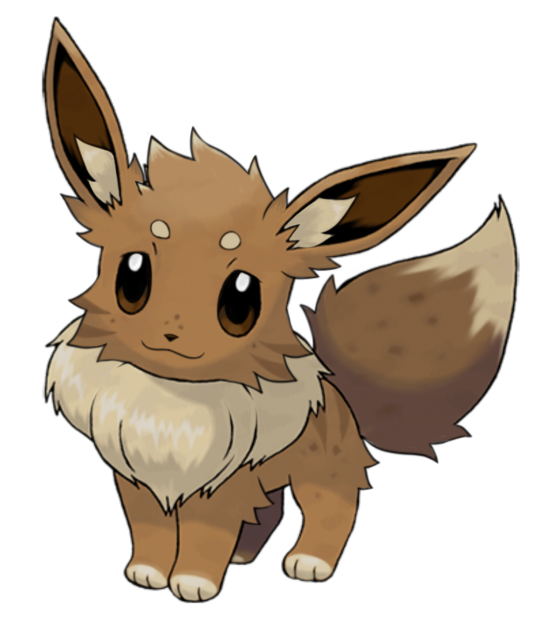
vaporeons may have a dorsal fin on its tail depending on its species and where its from. certain climates require faster or easier turns in the water, which results in them evolving this additional fin. they may also have fins on their forearms and legs. despite them being sort of blubber-y, vaporeons can appear fluffier if they are from a colder environment. of all patterns, they most often have spots and stripes like a tiger shark. they can have purple, pink, or blue eyes. when a lop eared eevee evolves into a vaporeon, their ear-like fins are lower.
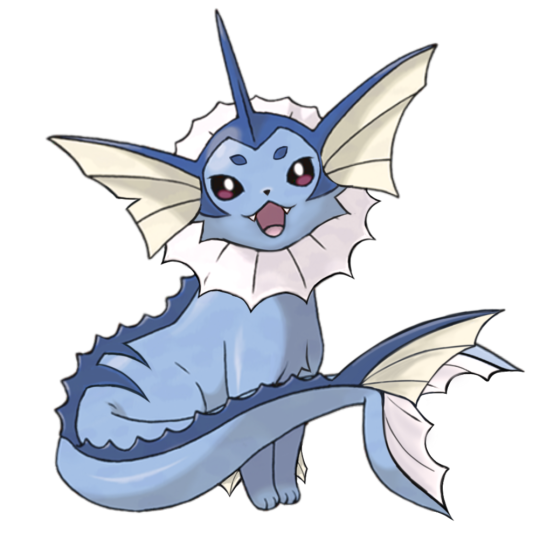
like the domestic cats that they resemble, espeons have a wide variety of purple hues and patterns. they also have many different shapes of forehead gems, sometimes even being a heart. people speculate horoscopes for the shape of an espeons forehead gem in relation to their personalities, but none of it is professor oak approved. their tail can be split at diffurent points from the base of the tail to the very end of it. on rare occasions, an espeon will have two tails or one tail that is ever so slightly split at the end. an espeons eyes can be purple, pink, or blue. when a lop eared eevee evolves into espeon, it is not very noticeable as espeons ears are more cat-like as compared to the rest of the eeveelutions.

flareons can grow a lot of head fur, which is fun to cut into different haircuts. in the wild, a flareon will simply burn the extra hair off if it gets too long. (unsure of this since that would mean it is not fireproof, but whatever) they can have lots of patterns as well, especially point patterns and stripes. their orange and yellow coat can vary in darkness and hue as well, and although blue is most common, their eyes can be lots of different colors.
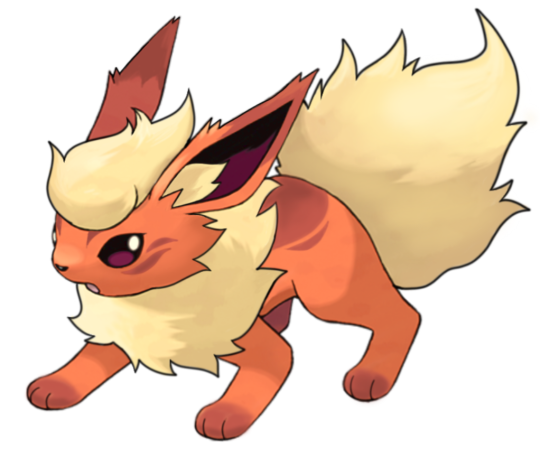
umbreons have the longest canines of all the eeveelutions, and sometimes they can be big enough to poke out from their mouths when closed. an umbreons rings also vary a lot, and can be anywhere on their bodies as long as they are symmetrical. they can also sometimes have freckles in the same color as their rings. even though they are black, they can have patterns that are visible in the light, including stripes, spots and points. their eyes can be red, brown, orange, or pink. umbreons sometimes grow a hyena-like mane along its head and back.
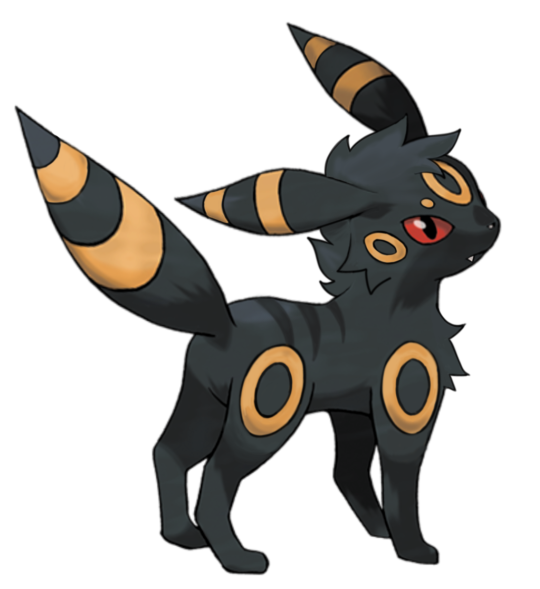
sylveons can have any number of bows on any part of their bodies, though the most typical places are at the base of the tail, the front or back of the neck, the ears, and the top of the head. multiple ribbons can grow from a sylveon's bow, and they can be all kinds of lengths at rest. the ribbon colors of pink, blue and cyan can be in any different order. they can have pink markings including stripes, spots and points. a sylveons widows peak can dip very low or not at all. their eyes can be blue, pink or purple.
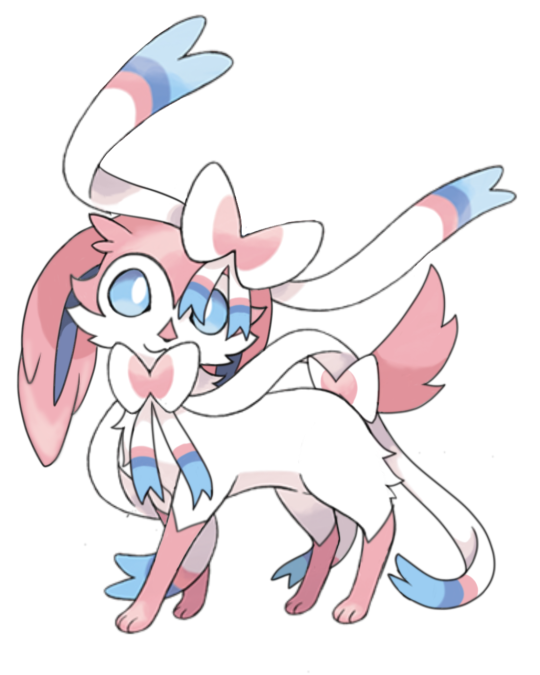
jolteons can sometimes have longer tails depending on their species. the size of the spines on their back also varies a lot, and they can grow as the jolteon gets older. they most often have orange stripes, but can also have spots and points. they will have white markings sometimes, too. sometimes they have markings in the shape of a lightning bolt. a jolteons eyes can be purple, pink, or red.
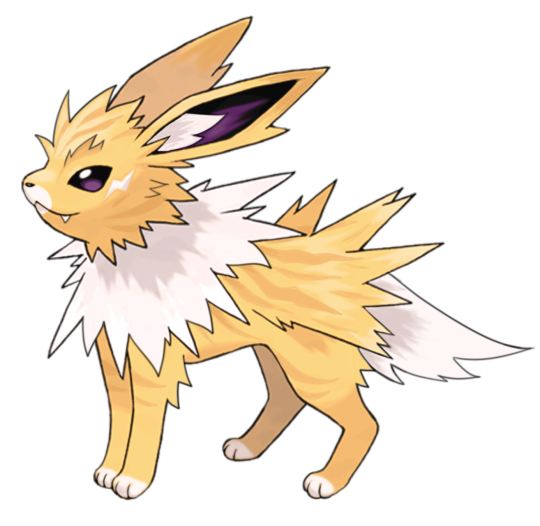
leafeons can grow lots of sprouts all over their bodies, and will usually have more the older they get. they can also grow flowers of many kinds, which will bloom and wilt with the seasons like normal. it doesn't hurt the leafeon to pick their flowers or trim their leaves, but it is reccommended to leave their sprouts alone unless they get excessively long as they help the leafeon photosynthesize. spots of brown or light greenish colors can appear on a leafeons leaves. they can also have stripes, spots, or points. they can have any shade of brown or green eyes, as well as blue on rare occassions.

lastly, glaceons vary a lot in their fur thickness depending on the fur it inherits from its eevee form. they don't require long fur as they don't need to stay warm, so its really only a vestigal leftover trait from needing to stay warm when it was an eevee. a glaceons "bangs" can be diffurent in shape and size. the same hard, thick ice that they are made from can sometimes appear on other parts of glaceons body, clinging to its fur like makeshift armor. if the ice is broken it does not hurt the glaceon. they too can have all kinds of patterns, including stripes, spots and points. they will often have diamond shaped patterns. their eyes can only be blue or brown.
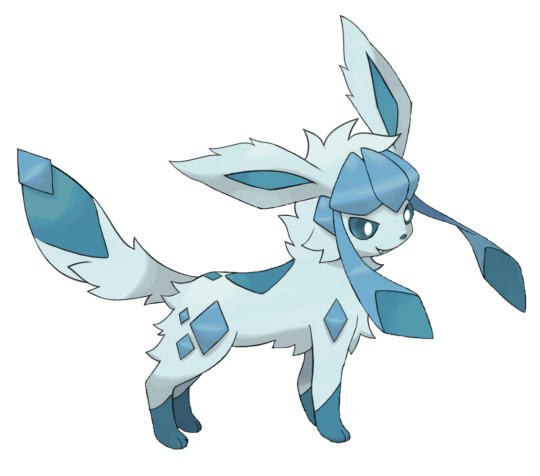
somewhat inspired by @belamew
that's all. might add more to this :pp

#pokemon#pokeblogging#pokeblr#eevee#pokemon eevee#eeveelution#vaporeon#espeon#flareon#glaceon#umbreon#sylveon#jolteon#leafeon#pokemon edits
100 notes
·
View notes
Note
Hi again ! I am creating a fielder and coastian oc and I was wondering if you had any color palettes for the two species (also drawing sonas for my friends based on your comic but that’s kind of beside the point)

This is from a very old fielder guide. Fielders are always beige to brown hues with light undersides and have tiny tails.
Coastians don't have a guide and aren't shown much in the comic, but their designs can vary a lot as long as the fur stays sleek. But then again coastians take in other breeds too as long as they accept their ways, then they become coastians as well. Well, not true coastians.
96 notes
·
View notes
Text







Skywings Ref
Horns:
Skywings’ horns are light and decorative. Because of this they will not often drill or carve into it like the other tribes.
They will be trimmed down if they are considered to be too heavy but back in the day large and cumbersome horns were a quality of the upper class. So much so that some would graft metal covers that would exaggerate their profile.
Wings:
Skywings have petaled wings that act like flight feathers. They are flexible and sharp along the edge. NO TOUCHING.
Instead of digits or talons along the wing they have a line of spurs that protect the bend of their wings.
Feathers:
Feathers are modified scales; they are strong and flexible like a sheet of thin metal.
Skywings often grow trains that can grow from three locations. It can grow from one or all three locations.
The length and quality of the trains is a sign of status and competence in combat if they are a warrior. Much like a lion’s mane or peacock’s tail, individual health plays a great part in the train’s appearance.
Criminals, lowlifes, orphans, and dragons in subservient positions often have their trains removed via clipping or yanking out. (ouch!)
If a dragon is in a higher social circle and does not grow trains in all locations might find it in them to add feathers. (These can be fabricated, from beloved family members, or trophies from rivals.)
Patterns:
Skywings vary less than the other tribes when it comes to colors, but they do have a number of interesting patterns.
Saturated colors are the sign of a more dominant individual. The brighter they are the better health, mood, and confidence. Or at least that is the general perception.
Each dragon has their own personal range of saturation. What might be considered a “bright” day to them might still look drab to another.
Red is considered the most desirable, especially at full saturation. Yellow and orange often tie in attractiveness. Brown isn’t very exciting but gives off the impression of being a stable if boring person. White is the wild card.
*Blue is exceedingly rare which only one documented individual that was truly blue. All other cases have be dye jobs.
Body Configuration:
Unlike the other tribes Skywings are exclusively bipedal. They never walk on their front talons thus keeping them extremely sharp.
While their hands are perfectly capable of holding things it’s not unusual for a Skywing to pick things up with their feet.
Skywings have unusual vents that resemble Seawings’ gills that they use to take in air without breathing thru their mouth or nostrils. These vents allow Skywings to breathe a continuous stream of fire hotter, farther, and longer than any other. No one is really sure how long a dragon can maintain the stream the longest record is 2 hours straight and only stopped out of boredom.
The vents can also expel fire, if rarely, to help flying and lift off. There is a skill to this, and it needs to be practiced with caution.
Extra:
Storm pattern appear to have correlations to a specific location.
Sky pattern is only uncommon, but the color blue is practically unheard of.
Skywings have shown an ability to change color within seconds, this is associated to levels of emotions. Anger and righteousness make the dragons more saturated, and fear and submissiveness make them duller.
Because of this correlation with brightness higher-class dragons are more saturated overall which causes a false assumption that brighter dragons are more qualified to rule and lead. (They just eat better, are more confident, and are more likely to anger.)
There's a myth that if two Hot Spots have eggs together, they will get a firescales dragonet.
There is a theory that Skywings were the first dragons that the other tribes descended from as they share traits with each tribe that are specific enough not to not shown in any other tribes. Example: Vents= Seawing gills, color change= Rainwing mimicry, etc.
124 notes
·
View notes